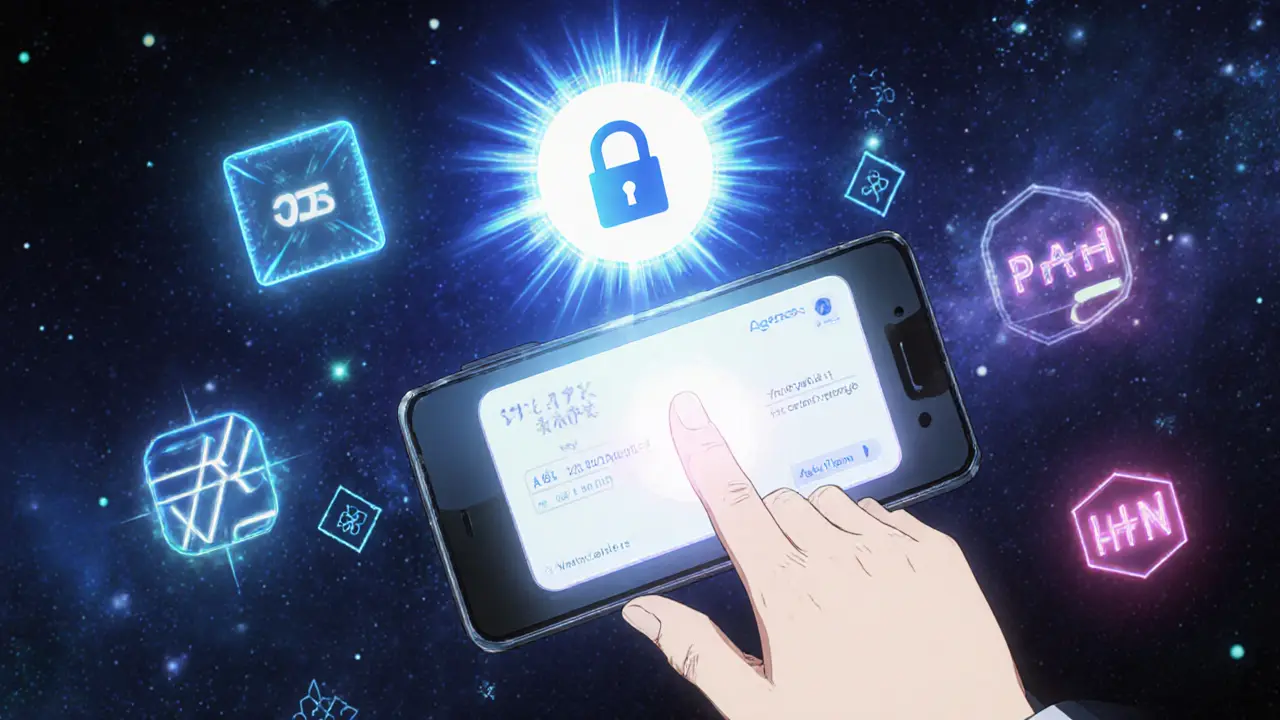Blockchain Identity Security Calculator
Compare Identity Security Risk
See how blockchain identity reduces security risks compared to traditional password systems
Security Risk Comparison
Based on 2022 Verizon data: 81% of breaches due to passwords
For each user accessing multiple systems, blockchain identity eliminates the primary attack vector: password reuse. Based on the 2022 Verizon report where 81% of breaches involved stolen or reused passwords.
Imagine logging into your bank, signing a lease, or proving you graduated college - all without typing a password or uploading a scanned ID. What if your identity was something you owned, not something a company or government held? That’s not science fiction. It’s happening right now, and blockchain is making it real.
Right now, most of your digital identity is locked up in databases owned by banks, social media platforms, and government agencies. These systems are slow, risky, and outdated. In 2022, Verizon found that 81% of data breaches happened because someone stole a password or reused one across sites. Your identity is being treated like a file you lost control of the moment you signed up. But blockchain changes that.
What Is Blockchain-Based Digital Identity?
Blockchain-based digital identity, also called self-sovereign identity, puts you in charge. Instead of storing your name, birthdate, or passport number in a central server, your identity is broken into small, encrypted pieces called Verifiable Credentials. These are linked to a unique digital address called a Decentralized Identifier (DID). DIDs live on a blockchain - not in a company’s database. You hold the keys. You decide who sees what.
For example, if you need to prove you’re over 21 to buy alcohol online, you don’t send your driver’s license. You send a cryptographically signed proof - generated by your phone - that says “this person is over 21.” The system checks the signature. It doesn’t see your name, address, or photo. No one else stores your data. You control the flow.
Why This Matters More Than Ever in 2025
By 2025, governments and businesses are under pressure to fix broken identity systems. The United Nations wants every person on Earth to have legal identity by 2030. Meanwhile, fraud is getting smarter. Deepfakes can mimic voices and faces. Phishing scams cost businesses billions. Traditional systems can’t keep up.
Blockchain identity solves this with three key advantages:
- No single point of failure: Hackers can’t break into one database to steal millions of identities. Data is spread across nodes.
- Zero-knowledge proofs: You can prove something is true without revealing the underlying data. Polygon ID uses this to verify age, citizenship, or credentials without exposing personal info.
- Speed: Verification that used to take 30-60 seconds now takes 2-5 seconds. Estonia’s blockchain-integrated system processes cross-border documents in under 10 seconds.
Companies like Microsoft and IBM are already using this tech internally. Microsoft’s Entra Verified ID connects to over 1,200 enterprise apps. In healthcare, one hospital cut patient onboarding time from 45 minutes to 8 minutes after switching to blockchain verification.
How It Works: DIDs, VCs, and Blockchain
Here’s the real breakdown:
- Decentralized Identifiers (DIDs) are unique strings - like a digital fingerprint - stored on a blockchain. They don’t point to your real name. They point to a public key you control.
- Verifiable Credentials (VCs) are digital documents issued by trusted parties - like your university, government, or employer. They’re signed with a digital signature and linked to your DID. Think of them like digital diplomas or passports you carry in your wallet.
- Blockchain doesn’t store your data. It stores the proof that a credential was issued and hasn’t been tampered with. Think of it as a timestamped ledger that says, “This credential was issued by Harvard on March 12, 2024.”
When you need to prove something, your wallet (on your phone) generates a cryptographically secure response. The verifier checks the signature against the blockchain. Done. No servers involved. No copies made.

Real-World Examples Already Working
This isn’t theory. It’s live.
- Estonia has used blockchain since 2023 to verify academic credentials, medical records, and business licenses across borders. Fraud dropped by 92%.
- The EU’s EBSI (European Blockchain Services Infrastructure) lets students, workers, and citizens verify diplomas, work permits, and tax records across 27 countries. Over 1.2 million verified credentials were issued by the end of 2024.
- Worldcoin registered 2.3 million people in 37 countries using iris scans to prove they’re human - not bots. It’s controversial, but it proves biometrics can work securely on blockchain.
- India is integrating its Aadhaar system with blockchain to reduce identity fraud in welfare programs.
These aren’t pilot projects anymore. They’re scaling.
The Big Challenges - And Why They’re Not Dealbreakers
It’s not perfect. Here’s what’s holding it back:
- Key management: If you lose your private key, you lose your identity. 34% of early adopters reported being locked out in the first six months. Solutions? Social recovery (trusted friends help reset access) and biometric key locks (face or fingerprint unlocks your wallet).
- Regulation: Only 37% of countries have clear laws for blockchain IDs as of Q3 2025. The EU’s eIDAS 2.0 regulation will make them legally valid by June 2026. The U.S. is scattered - only 17 states have laws.
- Usability: Non-tech users find managing keys confusing. Trustpilot reviews for consumer wallets average 3.8/5 - praised for security, criticized for complexity.
- Scalability: Most blockchains handle 50-100 transactions per second. Traditional databases handle thousands. Layer-2 solutions like Polygon ID are fixing this, with verification speeds dropping below 1 second by late 2025.
These are engineering and adoption problems - not fundamental flaws. They’re being solved faster than most people realize.

What’s Next? AI, Biometrics, and the Trust Fabric
The next leap isn’t just blockchain - it’s blockchain + AI.
By 2025, AI will monitor how your digital identity behaves across platforms. If your DID suddenly tries to access a bank account from a new country at 3 a.m., the system flags it - not because it knows your name, but because your behavior pattern changed. Your identity becomes a living profile, not a static file.
Biometrics are becoming standard. Multi-modal systems combine facial recognition, fingerprint, and iris scans to prevent spoofing. Gartner predicts these will be the norm by 2025.
And the “identity trust fabric” - a term used by Gartner - is emerging. It’s a network where governments, banks, universities, and apps all trust the same decentralized system. No more 10 different logins. One identity, verified everywhere.
Who’s Leading the Charge?
It’s not just startups. Big players are in:
- Microsoft - Entra Verified ID, integrated with Azure and Office 365.
- IBM - Hyperledger Indy, used by governments and enterprises.
- Polygon ID - Fast, low-cost, ZK-proof based, now powering major EU and U.S. pilots.
- Civic and SelfKey - Consumer-focused identity wallets with strong privacy features.
Meanwhile, governments are moving fastest. Estonia, the EU, Singapore, and Japan are building national blockchain identity infrastructures. The U.S. is lagging, but state-level pilots are growing.
Should You Care? Yes - Even If You’re Not a Tech Expert
You don’t need to code a smart contract to benefit. In 2025, you’ll likely use this tech without realizing it:
- Signing a rental agreement on your phone in 30 seconds.
- Getting a loan without sending your pay stubs to five different lenders.
- Applying for a job and sharing only your verified skills - not your entire resume.
- Traveling internationally with a digital health passport that’s instantly verifiable.
The shift isn’t about replacing passwords. It’s about replacing trust. Instead of trusting a company to protect your data, you trust math - cryptography - and the blockchain’s immutability.
By 2030, 83% of identity experts believe blockchain-based systems will be the standard. The question isn’t if - it’s when you’ll start using it.
Can I really own my identity on blockchain?
Yes. With decentralized identifiers (DIDs) and verifiable credentials, you control what data is shared, with whom, and when. No company holds your data - you do, encrypted on your device. You grant temporary access using cryptographic signatures, not passwords.
What happens if I lose my private key?
That’s a real risk. Losing your key means losing access to your identity. But new solutions are emerging: social recovery (trusted contacts help reset access) and biometric key recovery (your face or fingerprint unlocks a backup). Most enterprise systems now include these features. Consumer wallets are catching up.
Is blockchain identity more secure than passwords?
Far more secure. Passwords are the #1 cause of data breaches. Blockchain identity uses cryptographic keys and zero-knowledge proofs. No passwords. No central database to hack. Even if someone intercepts your verification request, they can’t reuse it or steal your data.
Will governments adopt this?
Already are. The EU’s eIDAS 2.0 regulation, effective June 2026, gives blockchain IDs full legal status. Estonia, Singapore, Japan, and parts of Canada are piloting national systems. The U.S. is slower, but state-level adoption is growing. Governments need this to meet UN goals for universal legal identity by 2030.
Can I use this for everyday things like shopping or banking?
Yes - and you already might. Some banks let you verify your identity using blockchain wallets instead of uploading documents. Retailers are testing it for age verification. By 2026, you’ll see “Verify with Digital ID” options at checkout, rental kiosks, and airport gates.
Is my biometric data safe on blockchain?
Your raw biometric data - like your iris scan or fingerprint - never goes on the blockchain. Only a cryptographic hash is stored. That’s a unique number generated from your data, but it can’t be reversed to recreate your face or fingerprint. Systems like Worldcoin and Polygon ID use this method to prevent surveillance and misuse.

Marianne Sivertsen
October 5, 2025 AT 03:16This is actually kind of beautiful. Imagine not having to send your entire life story every time you want to rent an apartment or open a bank account. It’s like finally getting a key to your own house instead of begging the landlord for a copy.
Stephanie Alya
October 5, 2025 AT 03:18Oh great. So now instead of corporations stealing our data, we get to lose our identity because we forgot our password. 😅
Jennifer Rosada
October 5, 2025 AT 03:20Let me get this straight-you want to replace the flawed but regulated systems of identity with unregulated, untraceable digital keys controlled by... who? Tech bros? This isn’t freedom, it’s anarchy dressed up as innovation.
adam pop
October 5, 2025 AT 03:23Blockchain identity? More like government backdoor #7. They’re not giving you control-they’re just moving the surveillance from servers to your phone. And don’t tell me about zero-knowledge proofs. If they can verify you’re over 21, they can verify you’re ‘suspicious.’
olufunmi ajibade
October 5, 2025 AT 03:25In Nigeria, we’ve been dealing with fake IDs for decades. If this tech can stop people from using someone else’s birth certificate to get a loan, I’m all in. But please make it work on a 3G connection.
Dimitri Breiner
October 5, 2025 AT 03:28I’ve used Microsoft’s Entra Verified ID at work. It cut our onboarding time from two days to two hours. No more PDFs, no more emails back and forth. People who say it’s ‘too complicated’ just haven’t tried it. It’s like switching from fax to email-once you do, you wonder why you ever tolerated the old way.
LeAnn Dolly-Powell
October 5, 2025 AT 03:30I’m so tired of being asked for my driver’s license just to sign up for a gym. This feels like the future I’ve been waiting for. Thank you for writing this. 💙
Anastasia Alamanou
October 5, 2025 AT 03:33The architecture here is fundamentally sound: DIDs as immutable anchors, VCs as portable assertions, and blockchain as a trustless verification layer. However, the UX gap remains the primary adoption barrier. Until the average user can recover their key without needing a PhD in cryptography, this will remain a niche enterprise tool-not a public utility.
Rohit Sreenath
October 5, 2025 AT 03:35You think this is new? People have been trying to fix identity since the 1990s. Everyone says blockchain is the answer. But who’s really in control? Always the same people with the servers. You’re just giving them a new name.
Sam Kessler
October 5, 2025 AT 03:38Let’s be honest: this is just Web3 vaporware with a fancy whitepaper. Zero-knowledge proofs? Please. If it’s so secure, why do all the major players rely on centralized relays? It’s a shell game. The blockchain is just the magic hat.
Steve Roberts
October 5, 2025 AT 03:40So now we’re supposed to trust math? What’s next? Trusting the algorithm that decides if you’re ‘worthy’ of a loan? This isn’t liberation-it’s automation of bias. The same old gatekeepers just got new code.
John Dixon
October 5, 2025 AT 03:43Ohhhhh, so now we’re supposed to believe that ‘cryptography’ is the answer to everything? You know what else was supposed to solve everything? Y2K. And remember how that turned out? 😏
Brody Dixon
October 5, 2025 AT 03:45I’ve seen people get locked out of their digital IDs. It’s heartbreaking. One guy couldn’t access his medical records because he lost his phone. He was diabetic. No backup. No recovery. We need better safety nets before this goes mainstream.
Mike Kimberly
October 5, 2025 AT 03:48The real breakthrough isn’t the technology-it’s the cultural shift. We’re moving from a model of institutional trust to one of cryptographic trust. That’s profound. Governments have spent centuries building bureaucracies to verify identity. Now, a single cryptographic signature, verifiable globally, replaces them. This isn’t just efficiency-it’s a redefinition of sovereignty.
angela sastre
October 5, 2025 AT 03:50My grandma used this to sign her rental lease on her iPad. She didn’t even know what blockchain was. She just tapped her face and said, ‘Done!’ That’s the win. Not the tech-how easy it made life.
Patrick Rocillo
October 5, 2025 AT 03:53This is the kind of shit that makes me feel like we’re living in the future. No more uploading scanned IDs to sketchy websites. Just tap your phone, boom-you’re verified. And yeah, I’m already using it to buy weed online. 😎
Aniket Sable
October 5, 2025 AT 03:55in india we have aadhaar and its already kinda like this. but its still linked to govt. if this can make it private and not tied to state, then yes please. also plz make app work on jio phone
Santosh harnaval
October 5, 2025 AT 03:58India’s Aadhaar is centralized. This is decentralized. Big difference. Simple. Clean. Works.
Claymore girl Claymoreanime
October 5, 2025 AT 04:00Of course you’re excited. You’re not the one who’s going to be profiled by AI algorithms that decide you’re ‘high risk’ because your DID pattern ‘deviates’ from normative behavior. This isn’t freedom-it’s algorithmic control with better PR.
Alex Horville
October 5, 2025 AT 04:03You people act like this is some kind of revolution. It’s just another Silicon Valley fantasy. The U.S. government doesn’t care about your ‘self-sovereign identity’-they care about tracking you. This tech will be co-opted faster than you can say ‘privacy.’